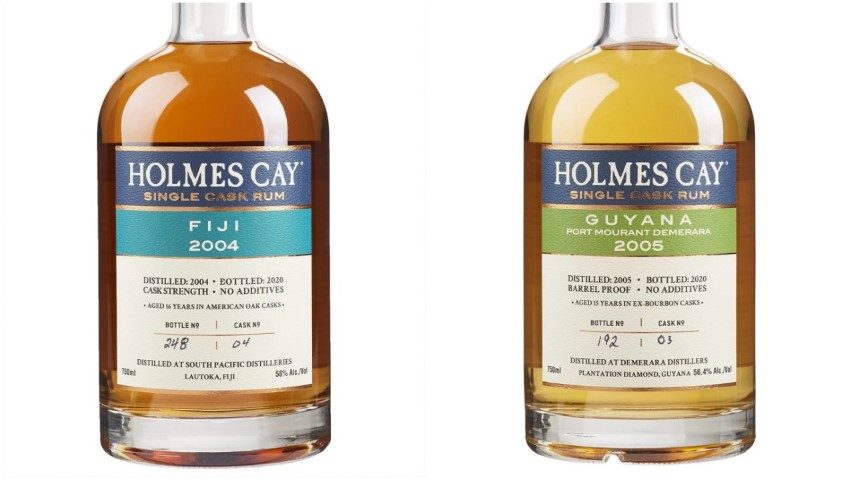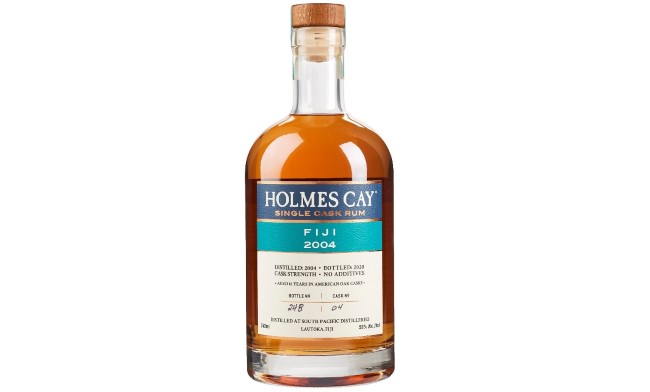
Tasting: Holmes Cay Fiji 2004 and Guyana 2005 Rums
by Jim VorelThe idea that “transparency” is the sexiest feature to be found on a liquor bottle is true of almost all corners of the spirits industry, but that goes doubly when we’re talking about rum. No other spirit is so consistently plagued by misinformation and misunderstandings, which has led to a drinking culture that sees rum consistently on the rise, but still shrouded in a veil of confusion. Whereas barrel-proof, single barrel bottlings of bourbon are produced in relatively large quantities and hotly contested by whiskey collectors, similar rum bottlings tend to be the domain of only the geekiest tiki nerds, ourselves included. Meanwhile, many bottles labeled as “premium” rum on the shelf are actively misleading in some way, filled with artificial color, additional sweeteners and often implying a greater age statement than they actually possess.
If any company is ever going to help contribute to a change in how premium rum is perceived, though, it might very well be Holmes Cay. The young boutique bottler focuses entirely on sourcing exceptional, well-aged, unadulterated casks of spirit from classic rum-producing regions, and deeply impressed me with its first 2019 release, Holmes Cay Barbados 2005. That rum was a 14-year-old beauty from Barbados’ famed Foursquare Distillery, bottled at a burly 128 proof cask strength, and a flavor bomb by any possible measure. But what was even more impressive was the purity of Holmes Cay’s mission: Just bottle the rum, give all the details, and sell it. No additional finishing casks. No gimmickry. No special selling points. They just let the rum speak for itself, and that’s literally all I want when it comes to rum!
And so, it’s not surprising that I was excited to hear that two more (sadly very limited) bottlings of Holmes Cay had arrived, each representing a new rum region. Together, they’re a study in contrasts: A 2004 rum from Fiji, and a 2005 demerara rum from Guyana’s Port Mourant Distillery. Taken together with the previous Barbados 2005 release, they’re indicative of just how different these aged rums can be, even without additional wine barrel finishes or anything of the like.
Let’s get to tasting.
Holmes Cay Fiji 2004 Rum
MSRP: $159

This is a single cask of 16-year-old rum, at a barrel proof of 116 (58% ABV), which equates to only 240 bottles. Both of these releases, in fact, are considerably smaller even than the 500+ bottles of the Barbados 2005 release, and one must wonder if Holmes Cay eventually intends larger releases that are multiple single barrels, or batched releases that will give more customers a chance to sample these rums. Regardless, the 16 years includes 12 years of tropical aging in Fiji in bourbon barrels, followed by 4 more years in the U.K. in re-used rum casks. It has a somewhat darker mahogany hue than the noticeably lighter Guyana rum.
On the nose, this one smells classically rich. I’m not sure I’ve ever sampled Fijian rum in the past, but I would have assumed this was Caribbean if I was tasting it blind—somewhere between the character of Barbados and Jamaica, to my still novice palate. I get big notes of banana pudding, some cocoa and slightly earthy notes. That’s hints of funk, but more in an estery Jaimaican sense than the sugar cane/vegetal funkiness of rhum agricole.
On the palate, this is quite soft for the proof, with an immediate burst of brown sugar and baking spices, along with moderate oakiness. Notes of allspice, candied ginger and citrus are present, as is some earthy cigar wrapper-type character, and the alcohol is quite mild for the 116 proof. This definitely drinks easier than the Barbados 2005 did, although it’s less of a bombastic flavor monster, even if it has some similar elements. It finishes with a bit of tannic, woody dryness and oaky spice, and deftly balances richness and drinkability. A very solid rum overall, and a good entry into Fijian rum for me.
Rating: 8.3
Holmes Cay Guyana Port Mourant Demerara 2005
MSRP: $149

You may have seen the term “demerara rum” in liquor stores or cocktail bar menus, but it essentially just means the rum of South American republic Guyana, which is produced in the Demerara region. There’s only one distilling company left in the world of demerara rum—that would be Demerara Distillers Limited—but their output is extremely influential, and they operate several different stills, producing different styles of demerara rum. These rums go into their own product lineups, such as the El Dorado rum line, but are also sold to independent bottlers and blenders, who use the distinctive demerara profile to achieve specific flavors in their blends.
As for this rum, it was produced at Port Mourant, on the distillery’s completely unique, 300-year-old double wooden pot still—the only one of its kind left in existence. Like the Fiji release, it’s a single barrel at cask strength, but that barrel produced an even more limited 180 bottles. It rings in at 112.8 proof, or 56.4% ABV, and was aged 15 years in the U.K. in recycled American rum casks, which explains the somewhat lighter color in comparison with the Fiji. As Holmes Cay puts it, “what is bottled is what went into the cask 15 years ago.” It’s that simple.
Tasting this one, it’s immediately clear that it’s something unlike anything I’ve sampled before—clearly, I haven’t consumed much high-proof demerara rum neat in the past. It’s considerably more funky on the nose, with earthy notes that bring rhum agricole to mind, followed by sweet and juicy pineapple. Like the Fiji, the booze is very mellow on the nose, allowing you to suss out notes of pepper and slight smoke, which I wasn’t expecting.
On the palate, this one is vivacious indeed. Bright and punchy, it brings notes of banana and pineapple juice, but then takes a hard left turn into dry oak and almost peat-like earthiness and hints of smoke. That gives it an unexpected scotch-like quality, but that peaty note fades out into a long, molasses cookie. The wood, likewise, has a resinous quality—I can’t help but wonder if the wooden pot stills have something to do with this?—that makes one think of pine needles. Alcohol heat is a bit more present than on the Fiji, but it’s still fairly drinkable neat. Once again, it’s not quite as big a flavor monster as the Barbados, but this one is very unique, and I really enjoyed trying to figure it out. I look forward to returning to it soon.
Rating: 8.5
All in all, these two new Holmes Cay releases are exactly what I want to keep seeing from the company: Unique, eclectic slices of the worldwide rum scene, which have nothing to get in the way of the purity of the spirit. The simpler they keep this concept, the more illuminating it is.
If you love rum, or want to taste what unadulterated rum is all about, go out of your way to get a chance at sampling these.
Jim Vorel is a Paste staff writer and resident brown liquor geek. You can follow him on Twitter for more drink writing.